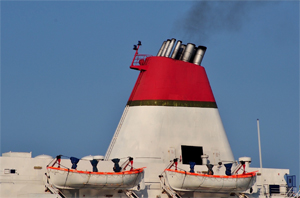Starting in January 2020, the International Maritime Organization (IMO) will impose a 0.5 percent sulfur cap on marine fuel content, in what independent shipping analyst Ned Molloy called “the biggest change in what ships run on since they moved away from coal to oil.”
According to Annex VI of the International Convention for the Prevention of Pollution from Ships (MARPOL), the sulfur cap applies to all ships, with exceptions provided for situations involving the safety of a ship or saving a life at sea, or if a ship or its equipment is damaged. Most nations have signed on as parties to the agreement. Ships operating in Emission Control Areas (ECAs) in Europe and the Americas are already subject to a lower sulfur limit of 0.1 percent, which will not change.
“MARPOL Annex VI has 91 parties, between them covering 96 percent of world merchant shipping by tonnage,” said Natasha Brown, media and communications officer for the IMO.
Heavy fuel oil, the most common marine fuel in use, typically has sulfur content of just under 3 percent, which complies with the IMO’s current cap of 3.5 percent. But the new cap, designed to improve air quality by limiting sulfur oxide emissions, has prompted concerns among operators about the cost and availability of low-sulfur fuel oil (LSFO).
According to the IMO, operators who have these concerns may install scrubbers to remove sulfur oxide from exhaust gases, allowing them to continue using high-sulfur fuels. But multiple IMO member states have raised concerns about the adverse impacts of scrubber use. The most extensive report on the topic, published in 2015 by the German Federal Environment Agency (translated UBA), examined the impacts of scrubbers on ports and coastal waters.
“Scrubbers achieve the required emission reduction, but generate wastewater which is discharged into the marine environment,” the report’s summary states.
In the report’s environmental impact assessment, UBA found that the use of scrubbers can result in decreased pH, increased temperature, and the introduction of pollutants like heavy metals to coastal waters. The IMO requires that discharged washwater have a pH of no less than 6.5, with exceptions made during maneuvering and transit. The organization also requires treatment systems like scrubbers to minimize suspended particulate matter like heavy metals.
The UBA report called open-loop scrubbers “particularly impairing” because they use large amounts of water. In an open-loop system, water is pumped into the scrubber as a washing medium and is then discharged directly back into the sea.
Open-loop scrubbers are much more common than closed-loop systems, which require ships to dispose of their sulfurous waste while in port, according to Molloy. But the IMO accepts all types of scrubbers, as long as they achieve the emissions reduction required by MARPOL Annex VI.
While negotiating Annex VI, which entered into force in 2005, “governments rejected the option of achieving compliance with the fuel oil sulfur limits using compliant fuel oil alone, as several wanted the policy option of using ‘equivalents’ including emission abatement technologies,” said Lee Adamson, head of public information services for the IMO.
 |
|
Courtesy ABS |
But recently, the United Kingdom, Germany and the Netherlands requested that the IMO review its washwater guidelines in an effort to better understand the environmental impact of discharging sulfurous scrubber water. The IMO has since established a correspondence group that aims to “further refine” guidelines issued in 2015 for exhaust gas cleaning systems, Brown said. Revisions to the guidelines, she added, should be finalized by May 2019.
Operators who install scrubbers might have another problem to consider in addition to their impact on the world’s oceans, Molloy said.
“I think in more and more ports, shipowners, even with scrubbers installed, won’t be able to find high-sulfur fuel oil anymore because there’s no point in bunker suppliers stocking it,” he said.
Molloy estimated that 2,000 to 5,000 ships could have scrubbers installed by 2020, less than 10 percent of the global commercial fleet of roughly 52,000 vessels. Despite the relatively small number of ships expected to use scrubbers, Molloy called the UBA report “worrying,” citing the high amount of sulfurous wastewater emitted on a typical ship’s journey.
For a ship consuming 12,000 metric tons of fuel per year, it could take two to four years to recover the cost of installing a scrubber, given that heavy fuel oil costs about $100 less per metric ton than low-sulfur fuel. Scrubbers cost anywhere from $2 million to $5 million, Molloy said.
As 2020 draws closer, heavy fuel oil should decline in price, while LSFO prices will likely increase. The magnitude of these price changes is difficult to estimate, according to Molloy. But operators who install scrubbers face an “underappreciated risk,” he said, because cost savings “only matter if there’s high-sulfur fuel oil available when you turn up in port to realize those discounts.”
Regarding LSFO availability, Molloy said industry concerns are largely overblown. He expressed confidence in the market’s ability to adjust to a global rise in demand for middle distillates, a category that includes low-sulfur fuels.
“When you look at total shipping oil demand, it’s only 5 percent of world oil demand, so even big shifts in the type of oil that ships run on is a small adjustment for the global oil market to make,” he said.

